The Right Knife
There’s nothing more challenging than cooking in someone else’s kitchen! You don’t know where anything is, and you often lack specialized cooking equipment that you’ve come to love and depend on. But the worst, once you’ve experienced cooking with good knives, is cooking with bad knives!
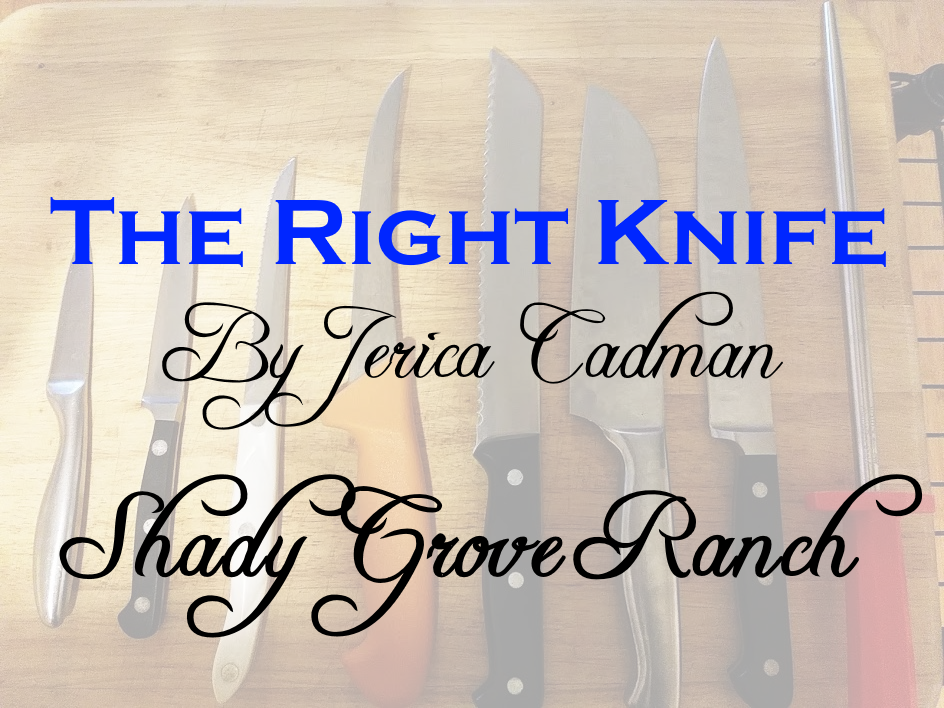
Do you have bad knives?
I house-sat for about a week many years ago, and the memory of that experience that stands out most prominently in my mind, is how very dull and flimsy the knives were! I don’t even know what I was trying to cook, but it was miserable!
And today it occurs to me… what if that’s you? What if you don’t even know how fun cooking can be because you have to fight with knives so poor that you can’t tell which end is the sharp one! I hope that’s not you, but in case it is, don’t run out and buy a $600 set of knives. I’ll share my own bare-bones favorites and you can begin building your collection one great knife at a time.
I must mention that I’m no chef, and a lot of my knowledge is accidental or gathered the hard way, but if my advice, amateur as it is, helps you get back in the kitchen making healthier food for your family, I have succeeded!
You don’t need all the knives.
I could probably narrow it down to 4 knives if I really had to, but my favorites are these 7, and each for a very specific reason.
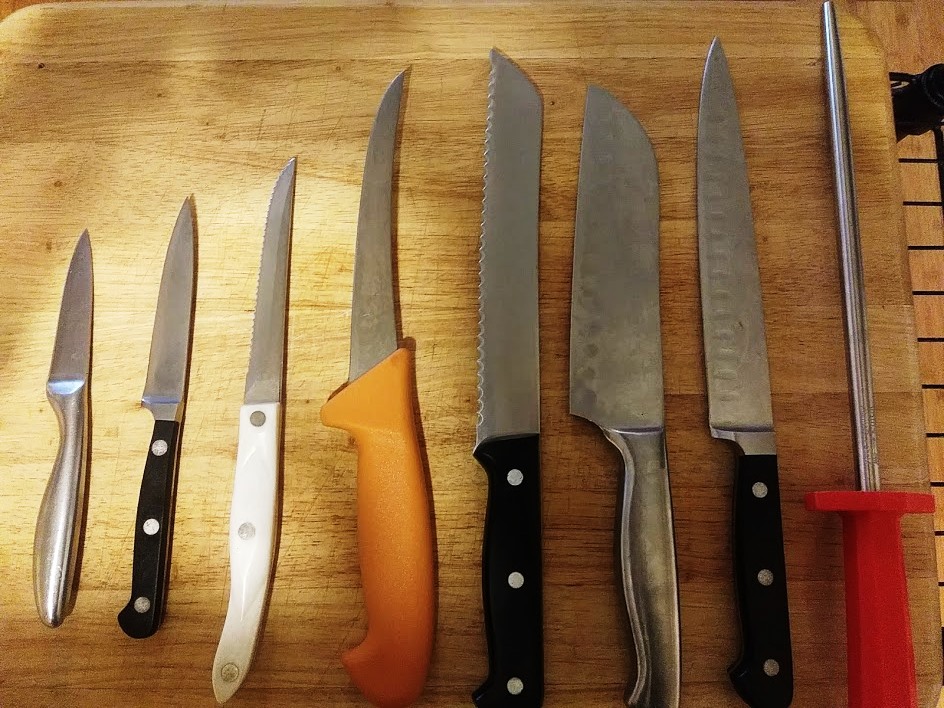
I thought it might be useful for me to tell you about each one, starting at the left:
The Paring Knife
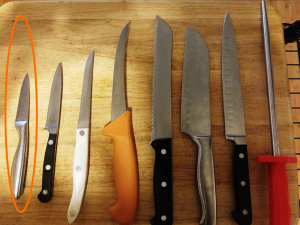
This little beauty is nice because it has a short, agile blade great for efficiently carving out the seeds and hulls of fruit or bruised veggies. My favorite feature of this particular knife is the ergonomic handle. It’s got a nice fat part that sits in your palm, then a narrower part that helps you keep a great grip on the knife. And it’s all one piece of stainless steel and will never deteriorate in the dishwasher!
The Multipurpose Knife
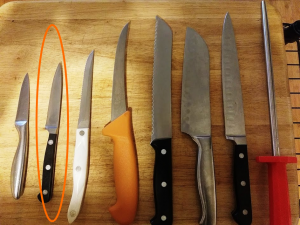
This black-handled knife would probably also fall under Paring Knife category, and although it doesn’t have the fancy contoured handle, I love it because the blade is long and not too thick, so that cutting things like cheese and apples is easy. But the size of the knife is still small enough to be very easy to handle when doing more intricate cutting. Be careful when shopping for knives that the wedge of the knife isn’t too thick that cutting becomes a chore. This one has a nice thin blade that is still very stiff.
How Steep is Your Wedge?
I thought I’d share this cute little illustration to make this point a little clearer. If you and your friend are headed someplace fun together, steep ramps are going to much more difficult to go up than shallow ramps. The knife is really a wedge tool, and the shallower the wedge, the easier the work is to do (though if you’re going somewhere, it will take longer, but that’s a discussion for another place…). Like my drawing? 🙂
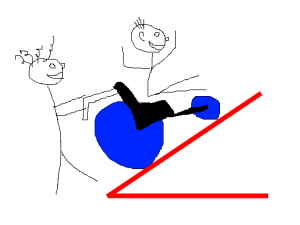
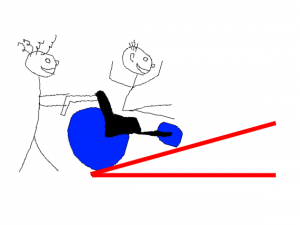
The same principle is true in a knife. It’s a lot more work for you to force a steep-wedged knife through a hunk of cheese or squash or whatever than to use a very thin knife. However, the thinner the blade, the less rigid/stiff/strong it will be, and so cutting very hard things like raw pumpkin can be dangerous with a very thin blade because the blade can warp or even permanently bend and cause injury to you or your pumpkin! Choose wedge thickness carefully!
Edited to add: I just ran this by my physics-expert hubby (who was actually my tutor in college… I’m more of a “chemical” engineer, you know!). He said my example is just a little too oversimplified. The work done by the knife really has more to do with the normal force and the modulus of elasticity of the food, such as cheese, as well as friction…. LOL I know. He’s perfect. All you other perfect physics engineers out there just overlook my explanations to the laymen like myself out there. 🙂 😛
The (Sharp) Serrated Knife
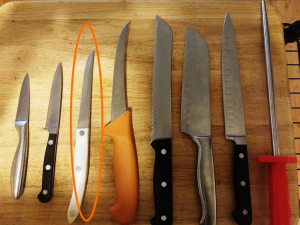
I only have a couple of Cutco knives, and the one I like best is this serrated knife. It’s wonderful for difficult-to-start things like tomatoes and other very soft fruits (yes, tomatoes are technically a fruit!). I also like to use it for things that have tough outsides, like onions and pineapple. I don’t care for serrated knives much in general, but this one gets well-used because the edges hold their sharpness very well. It’s no good to buy a cheap serrated knife that you can never sharpen. You also want to look for serrated knives that have balanced serrations. Not like this steak knife which is asymmetrical and will actually tend to cut on a curve:
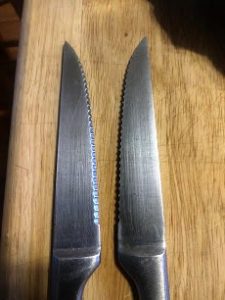
The Professional Boning Knife
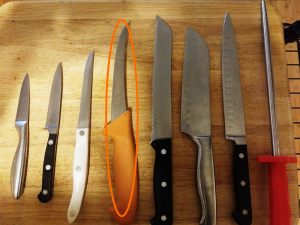
This is one of my very most favorite knives, but (pretty much) all I use it for is slicing raw meat. If you’d like to get into quartering chickens or cubing steaks/roasts for stews and fajitas, etc, this is the kind of knife you need.
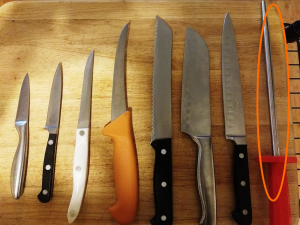
But you also need a good knife steel, the big fat thing over at the far right, which is used to realign the tiny metal molecules at the edge of the blade, causing it to keep the sharpest cutting edge possible. Raw meat, and especially skin and gristle, are very difficult to cut through with a less-than-sharp knife, and you end up sawing and ripping more than actually cutting, which is hard work and results in ugly workmanship and frustration. I use the steel to refresh my blade every time I prepare to cut. It’s well worth the investment, but DO NOT use it on a serrated knife!
The Bread Knife
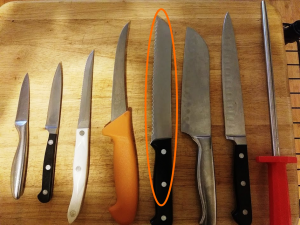
If you are into homemade bread at all, you need a great bread knife. Again, a poor-quality knife results in ripping instead of cutting, and a short-bladed knife won’t be able to reach all the way through a large loaf of bread, leaving you to have to cut from two ends, which will likely lead to goofy-looking slices. A very sharp knife with good even serrations is a joy to the baker. Since homemade bread (hopefully) doesn’t have all those nasty dough conditioning chemicals that store-bought bread does, it will be more crumbly and less tough than commercial bread, and you’ll need a knife that lends itself to not destroying the bread’s delicate texture. I like a serrated bread knife because it starts into the hard crust more easily than a smooth-sided blade.
The Chef’s Knife
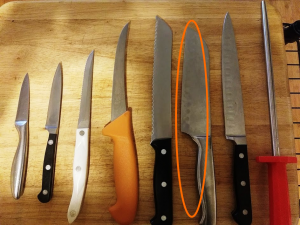
These last two knives are both technically chef’s knives, but as you can see, are shaped a bit different and have different beneficial characteristics. I like the stouter, silver-handled knife for these two reasons: it has the ergonomic handle, and the stouter blade gives me more leverage when chopping through hard vegetables like raw sweet potatoes. It’s also very broad and makes mincing nuts or onions easy work since they can’t “jump” over my blade as I’m working through a pile of food.
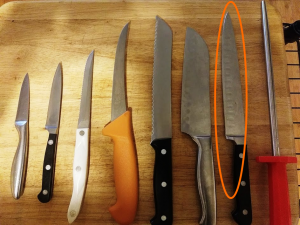
The black-handled knife has a longer, narrower blade that gives a bit more control for precision cutting and room to work. The long blade is handy for chopping things lengthwise like carrots, or really large things like cabbage. Both have “dimples” (I’m sure there’s some correct technical knife term, but I don’t know what it is) along the blade to help keep the food from sticking to the side of the blade as you slice through it.
Which is the BEST knife?
So there is Jerica’s simplified version of choosing good knives for the home cook. If I had to pick just one knife to take to a desert island… with an otherwise fully-equipped kitchen of course, haha… I would probably choose the multipurpose paring knife and sharpening steel. It’s my favorite knife because of the blade size, and I can do just about anything with it in a pinch. Hope you enjoyed this article! If you’d like notice of more stuff like this, please sign up for our newsletter! Happy cooking!

